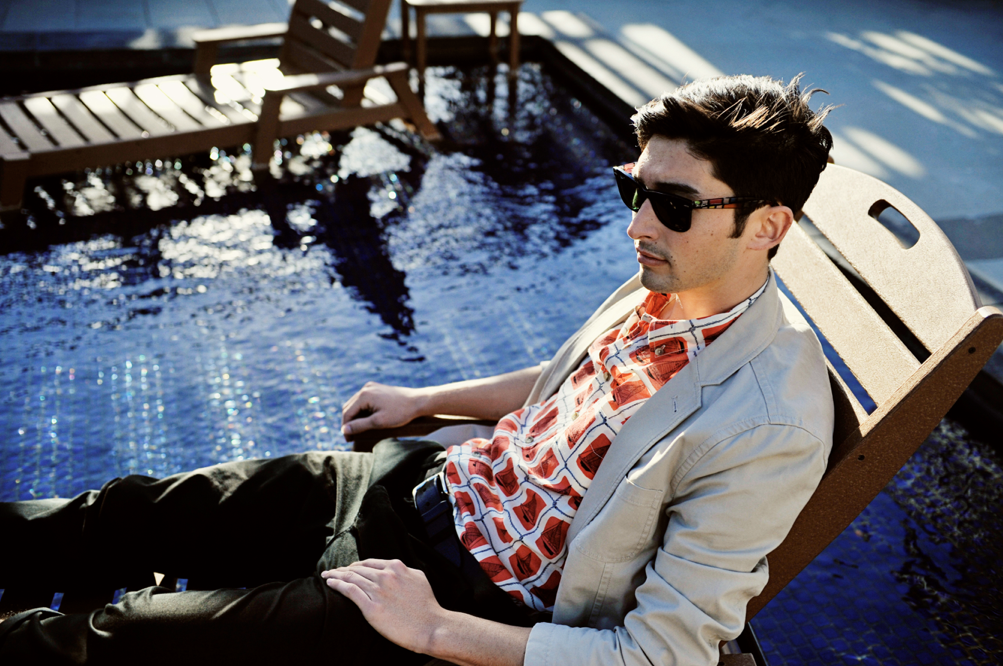The clothes that have defined our islands continue making statements in the islands and beyond.
Text by Anna Harmon | Images by John Hook
I can’t remember the first time I saw an aloha shirt. Growing up in Colorado, it may have been on a friend’s dad recently returned from that long-awaited vacation in Hawai‘i, or in a Hollywood spin like 50 First Dates. Not until I moved to O‘ahu did I realize that alohawear isn’t just a tacky tourist thing—it’s the real deal.
My boss, a 60-year-old local Okinawan woman, wore a muumuu to the office for a meeting and looked stunning. I saw downtown swarmed by reverse-print button-ups at noontime. I bought my first aloha print tank top. I got a job at a local restaurant and was issued that island-style service uniform: a set of three interchangeable pareau-print shirts in green, blue and khaki. I began to see that what alohawear means to each of us is complicated, and what makes us want to wear it (or not) has been determined by decades of tourism, garment and service industries, self-expression and a tropical setting.
From its brightly colored tropical prints to its more demure reverse-print fabrics, alohawear has come to define the look of Hawai‘i. The style itself dates all the way back to the 1820s, when the muumuu was born as a more island-friendly version of the floor-length cotton dress introduced by Protestant missionaries, but it wasn’t until a decade later that aloha shirts—now the alohawear signature—would make their debut.

Originating in the 1930s at a local tailor shop, the aloha shirt was quickly snatched up by tourists arriving by boatloads who wanted a “visual postcard” of their time in paradise. It became widely adopted by the local population as WWII limited garment exports and imports, and Hawai‘i folks found it truly did express and fit the islands’ vibes better than mainland fashions.
Inevitably, as with most fashion crazes, the style aged with the industry and population that first adopted the trend. But several of today’s designers—both locally born and mainland transplants—have plenty to say about the signature style. Reyn Spooner has been turning alohawear inside out since he 1960s and is again redefining what alohawear means today.
Though many once associated alohawear with the ware of old uncles and dads, Reyn Spooner is changing notions and turning heads with the launch of their Modern Collection four years ago. The collection features a slimmer fit and an overt reference to classic, vintage patterns, a nod to the fact that vintage shops and thrift stores have become a trending place to dig up favorite aloha shirts. They even collaborated with Opening Ceremony to create fashion-forward jumpers and summer dresses alongside tailored, classic aloha-print shirts paired with mid-thigh-length shorts and modeled by a ruggedly handsome, beach-blonde type.
Meanwhile a newer set of alohawear designers have cropped up, evolving the iconic look of Hawai‘i once again. With her expertly tailored men’s shirts and eclectic prints, Roberta Oaks’ shirts have become all the rage with both men and women, young and old. Sig Zane Designs, which originated out of a desire to celebrate the traditions that infuse Hawai‘i’s culture, are donned in settings both casual and formal, buttoned up to the neck and tucked into straight-leg dress pants or left loose and worn over shorts. Hand-printed using organic dyes and traditional tools and manufactured in Hawai‘i, Sig Zane Designs offers an authentic education about Hawai‘i’s lifestyle in modern cuts and prints.
Like clockwork every few seasons, brands ranging from Prada to Stussy to Forever21 draw inspiration from the islands’ prints and breezy cuts. But for Hawai‘i designers such as Jeffrey Yoshida, it’s less the look than the story behind it: “It would be so easy to say, ‘Oh alohawear is something in a Hawaiian print,’ but I don’t think that’s it necessarily at all. I think it’s really more of the feeling of how we live here on the islands.”

